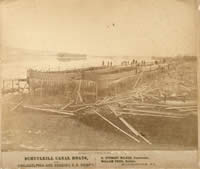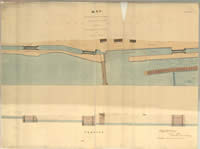Pennsylvania Canals - 1846
Images
Click images for larger versions.
History
Manuscript Group 218: Photograph Collection. Schuylkill Canal Boats being built for the Philadelphia and Reading Railroad Company, Highspire, Pennsylvania.
Record Group 17: Records of the Land Office, Records of the Secretary of the Land Office, Board of Canal Commissioners. Map Showing the Junction of the Wiconisco and Pennsylvania Canals at Clark's Ferry, 1846.
The canal era began in Pennsylvania in 1797 with the construction of the Conewago Canal that was built below York Haven and enabled boats to circumvent the Conewago Falls. During the subsequent four decades, hundreds of miles of additional canals and connecting railways were constructed in the Commonwealth, with most of the state's major canal building projects taking place during the 1820s and 1830s. Above and beyond the desire to move people and goods more efficiently, the impetus for these large-scale endeavors was the completion of the Erie Canal in New York State between 1817 and 1825. This canal gave New York a clear path to the country's interior waterways, and hence an overwhelming advantage over the transportation systems of its neighbors.
Construction of the Pennsylvania Canal commenced on July 4, 1826. From the beginning, an unbroken mountain in the Appalachian Mountain chain known as the Allegheny Front created a natural barrier that was overcome by the construction of the Allegheny Portage Railroad. A thirty-seven mile system of railroads and ten inclined plains, it was completed in 1834, just in time to allow Pennsylvania's canal system to open during that same year. By 1840, the Pennsylvania "Main Line" Canal encompassed 726 miles of waterways, associated railways, and inclined plains.
In addition to the Main Line, there were numerous other privately owned canal systems in the state. One of these independent canals was the Schuylkill Canal owned and operated by Schuylkill Navigation Company. Established in 1815, the Schuylkill Navigation Company completed the canal in 1825. Used primarily to transport anthracite coal from northeastern Pennsylvania to Philadelphia, it stretched for 108 miles between Port Carbon and Philadelphia, contained 120 locks and covered 57.73 miles. This canal was leased to the Philadelphia and Reading Railroad Company for 999 years in 1870 and continued to operate commercially until 1931. The photograph displayed here shows a number of workmen building Schuylkill Canal Boats for the Philadelphia and Reading Railroad during the 1870s. The work is being done on the banks of the Susquehanna River at Highspire, located just south of Harrisburg. The picture was probably taken during the early spring, or possibly late winter, as evidenced by the large chunks of ice floating in the river.
Building and maintaining the canals was an extremely labor-intensive proposition, one that required a good deal of brains as well as brawn. On April 11, 1825, the Pennsylvania legislature established the Board of Canal Commissioners to oversee the construction and maintenance of the state's canal system. Many of the country's top engineers were engaged to bring the Board's plans to fruition. Scores of laborers, Irish immigrants chief among them, were hired to dig canal channels and build numerous other structures associated with the canals, including lift locks, aqueducts, dams, reservoirs, feeders, canal basins, waste-weirs, tow-path bridges, canal-boat weighing locks and inclined planes. The records of the Canal Board are housed at the State Archives in Record Group 17, the Records of the Pennsylvania Land Office. Contained in this record group is a series of map books depicting various structures associated with the canal system. The map shown here depicts the junction of the Pennsylvania Canal and the Wiconisco Canal at Clark's Ferry, located roughly fifteen miles north of Harrisburg. Construction on the Wiconisco was started in 1838 by the state but completed by a private firm. It ran north for twelve miles to Millersburg and served as an essential outlet for the anthracite coalfields of Dauphin County, via the Lykens Valley Railroad junction at Millersburg.
The year 1852 marked the beginning of the end for the commonwealth's canal systems. That year the Pennsylvania Railroad (PRR) began offering rail service from Philadelphia to Pittsburgh when it opened its "Main Line" railroad. The PRR bought the state Main Line Canal at a public auction for $7.5 million on June 25, 1857. In 1859 the Board of Canal Commissioners was abolished and all canals owned by the commonwealth were sold. The Pennsylvania Canal Company was formed by the PRR in 1867, and a fair amount of freight was handled by various canal systems in the state until roughly 1875, when the business began a steady decline. By 1901, nearly all the commonwealth's canals were shut down, though a few continued to operate until the 1940s.

